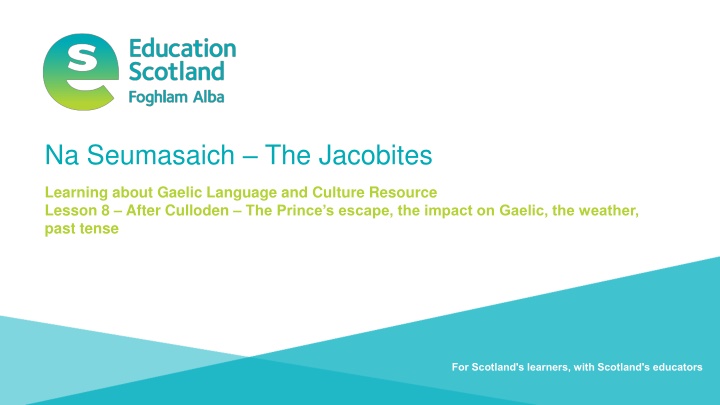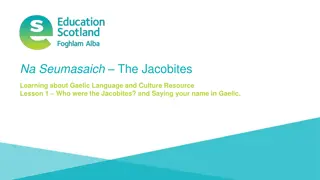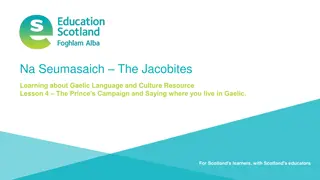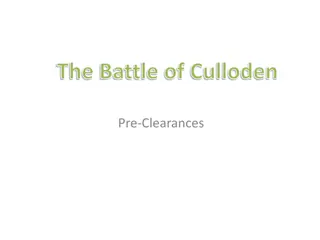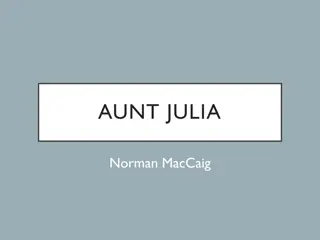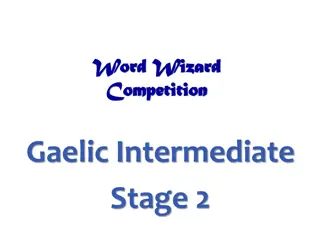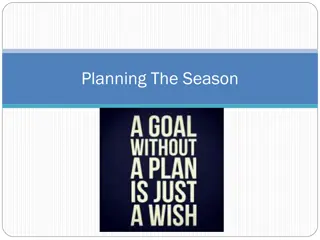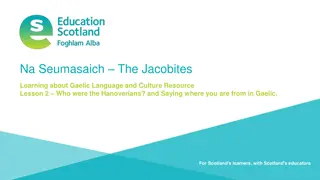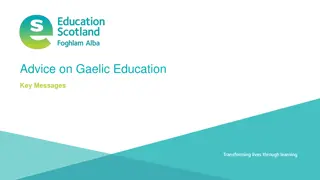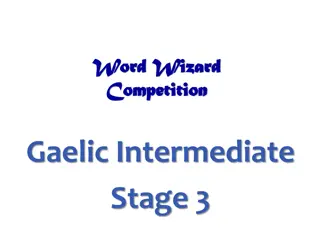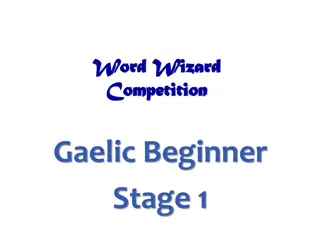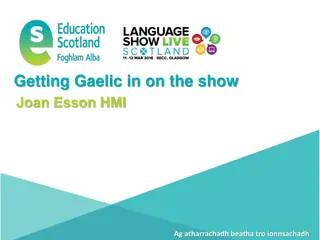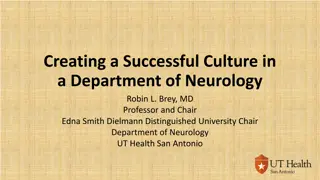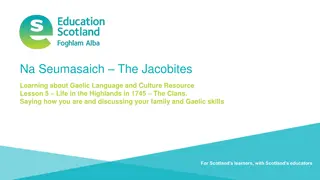Exploring Gaelic Culture Post-Culloden: Prince's Escape & Impact
Delve into the aftermath of Culloden through the daring escape of Bonnie Prince Charlie, the repercussions on Gaelic culture in Scotland, Gaelic weather discussions, and past tense usage. Unravel Prince Charlie's journey through the Highlands and Islands post-Culloden, reflecting on the enduring legacy of the Jacobites.
Download Presentation

Please find below an Image/Link to download the presentation.
The content on the website is provided AS IS for your information and personal use only. It may not be sold, licensed, or shared on other websites without obtaining consent from the author.If you encounter any issues during the download, it is possible that the publisher has removed the file from their server.
You are allowed to download the files provided on this website for personal or commercial use, subject to the condition that they are used lawfully. All files are the property of their respective owners.
The content on the website is provided AS IS for your information and personal use only. It may not be sold, licensed, or shared on other websites without obtaining consent from the author.
E N D
Presentation Transcript
Na Seumasaich The Jacobites Learning about Gaelic Language and Culture Resource Lesson 8 After Culloden The Prince s escape, the impact on Gaelic, the weather, past tense For Scotland's learners, with Scotland's educators
Na Seumasaich Lesson 8 In this Learning about Gaelic Language and Culture resource lesson we will learn: about how Bonnie Prince Charlie escaped from the British forces about the impact of the failure of the Jacobite rebellion on the Gaelic culture of the Highlands of Scotland to discuss the weather in Gaelic to use the past tense structure Bha/Cha robh to create short texts about ourselves and others in Gaelic to reflect upon our learning about the Jacobites and Gaelic
Miri and Calum Hal a Chaluim. tha i fuar an-diugh nach eil? Chan eil! Tha i teth! Och! Chan eil! Bha i teth an-d ! Bha i grianach cuideachd!
What happened after Culloden? Firstly, the British Government took action to ensure there would be no further rebellions. Gaelic speaking Highlanders suffered terribly. That s right. We learned earlier that they banned the kilt. Secondly, Bonnie Prince Charlie went on the run. This was an epic tale, and one which is still remembered today. That must be some story. Tell me a little about it.
Cuairt a Phrionnsa Bonnie Prince Charlie spent over 5 months on the run in the Highlands and Islands. You can use this resource to follow the Prince s escape from Culloden until his ultimate return to France. The Flight of Bonnie Prince Charlie - Story Map (jacobites.org.uk)
In the Hebrides After Culloden, the Prince headed towards Lochaber, where he had first landed. Eventually he made for the Western Isles where he thought it would be easier to get a boat to France. The Prince landed in Benbecula on the 27th of April and stayed two nights in an abandoned hut. He would then make for Scalpay off the coast of the Isle of Harris. The people of Scalpay still sing about their pride at not turning the Prince over despite the reward money available. He would try and return here when the people of Stornoway, Isle of Lewis would not let him enter their town. The Prince would then return to Benbecula and then South Uist, where he would spend almost 3 weeks in Coradail, even getting the chance to go shooting and hunting! However, as June dragged on, Government troops started to draw near. he had many narrow escapes in Eriskay in particular.
In the Hebrides - Questions 1. Where did the Prince stay his first couple of nights in the Western Isles? 2. What are the people of Scalpay still proud of today and how do they show this? 3. What shows that the Prince was able to relax a little when he was in South Uist?
Over the Sea to Skye On the 28th of June, the Prince dressed as the Irish servant of Flora Macdonald (Fionnghal NicDh mhnaill) called Betty Burke and set sail for Skye from Uist. Flora and the prince were accompanied by Neil MacEachain and four boatmen. They tried to land in Waternish, but were fired upon by troops. They then went to Kilbride in Trotternish where the Prince was able to stay in Kingsburgh House. A couple of days later, the Prince even spent a couple of hours in a pub in Portree. The Prince would leave from Elgol on the 4th of July 1746 for the mainland. He supposedly left the recipe for an alcoholic drink called Drambuie with Clan MacKinnon which is still popular today. The Prince would spend just over a week in Skye and Raasay but the Misty Isle has become linked with the image of the runaway Prince more than any other place.
Over the Sea to Skye Questions 1. What name did the Prince travel under with Flora Macdonald? 2. Why could they not land where they wanted to in Skye? 3. What did the Prince supposedly give Clan MacKinnon as a gift? 4. What is said about the Prince s connection with Skye and Raasay? 5. Find out about the history of the Skye Boat Song
Back on the Mainland and escape to France The Prince would spend several weeks roaming the hills and glens of Lochaber and Inverness-shire. He was able to live in relative peace in Strathglass for a few days, but often had to stay in caves, such as a famous one in Glenmoriston. Here the Prince was protected by the Seven Men of Glenmoriston, who did not turn him in even though the reward was 30,000 pounds (around 2.6 million pounds in today s money). He then headed east towards the Cairngorms, before coming back to Lochaber. The Prince travelled in all sorts of weather, sometimes staying only a couple of miles ahead of the Government troops. He would eventually leave Scotland for good on the 20th of September 1746 on a French ship from Loch nan Uamh (The Loch of the Caves). He lived out his days in Rome. His brother Henry inherited the Jacobite claim to the throne, but he was a Roman Catholic Cardinal and had no children. The Jacobite Stuart line came to an end.
Back on the Mainland and escape to France Questions 1. What kind of places did the Prince have to stay often? 2. How much would the reward money for the Prince be worth today? 3. How did the Prince finally leave Scotland? 4. What happened to the Jacobite claim to the throne when Charles died?
The Aftermath The British Government were determined there would never be another rebellion from the Highlands. So they brought in lots of laws to weaken the clan system, and therefore Gaelic culture. They hunted down many Jacobite rebels and executed many of them. The UK Parliament brought in the Act of Proscription in August 1746. This banned people in the Highlands from owning weapons. It also banned people from wearing the kilt in any part of Scotland. People could be fined, put in jail, and then sent to the colonies in the Americas if they refused to follow the new rules. These rules didn t just apply to Jacobites. Highlanders who supported the Government were also affected. The Clan Chiefs also lost a lot of their rights in another Act of Parliament.. This weakened their powers, but also meant that their connection to the people and land was weakened. The ban on the kilt and tartan was lifted in 1782. The weakening of the bonds between chiefs and clan members would contribute to the Highland Clearances in the 19th Century.
The Aftermath Questions 1. What did the government do to Jacobite rebels? 2. What did the Act of Proscription ban? 3. What were the consequences for breaking the law? 4. What effect did the weakening of the Clan chiefs power have? 5. When was the ban on tartan lifted?
"Mo rn geal g" (My fair young love) The failure of the rebellion affected thousands of people. "Mo r n geal g" (My fair young love) is a Scottish Gaelic lament written by Christina Fergusson for her husband, William Chisholm of Strathglass, who was killed at the Battle of Culloden in 1746. Fergusson was possibly born in Contin, Ross-shire. She was married to William Chisholm, who was a blacksmith, armourer and standard bearer for the Chief of Clan Chisholm. In the song, Christina rebukes Prince Charles Edward Stuart, saying that the loss of her husband in fighting for his cause has left her desolate. A roadside memorial marks the site of Chisholm and Ferguson's cottage, near Struy in Strathglass. The song has been performed by several notable singers, including Flora MacNeil, Julie Fowlis, and Anne Lorne Gillies. Listen to the song then discuss: What emotions do you hear in the song? How does the singer sound? CC BY-SA 2.0 Craig Wallace Flora MacNeil MBE sings 'Mo Run Geal Og' (My fair young love) - YouTube Traditional Celtic Song - Mo r n geal g - YouTube Flora MacNeil - Mo Run Geal Og (My Fair Young Love) (celticlyricscorner.net) CC BY-SA 2.0
An aimsir Tha i Here are some adjectives for the weather in Gaelic teth bl th stoirmeil tioram fuar gaothach sg thach ce thach fliuch grianach
An aimsir Tha i (support) Here are some adjectives for the weather in Gaelic stoirmeil stormy bl th warm teth hot tioram dry fuar cold gaothach windy sg thach cloudy grianach sunny ce thach misty/foggy fliuch wet
An aimsir Tha ann Here are some nouns for the weather in Gaelic re thadh tairneanaich is dealanaich sneachd turadh an t-uisge bogha-frois sg than ce a ghaoth a ghrian
An aimsir Tha ann (support) Here are some nouns for the weather in Gaelic re thadh frost tairneanaich is dealanaich thunder & lightning sneachd snow turadh dry spell an t-uisge rain bogha-frois rainbow sg than clouds ce mist/fog a ghaoth the wind a ghrian the sun
How to talk about the weather Ciamar a tha an t-s de? The weather in Gaelic an t-s de or an aimsir is a feminine noun, that means we use the pronoun i for the weather. Tha i fliuch It is wet Tha i fuar It is cold Chan eil i grianach It is not sunny If we use a noun instead we use the structure Tha ann Tha an t-uisge ann There is rain Chan eil sneachd ann There is no snow To ask someone how the weather is, you ask: Ciamar a tha an t-s de? or Ciamar a tha an aimsir? You can also add an-diugh for today Tha i teth Tha i fuar Tha sneachd ann Tha an t-uisge ann
How to talk about the weather in the past Ciamar a bha an aimsir? To say things in the past tense in Gaelic, you change Tha to Bha (and Chan eil to Cha robh) Bha i fliuch It was wet Bha i fuar It was cold Cha robh i grianach It was not sunny If we use a noun instead we use the structure Bha ann Bha an t-uisge ann There was rain Cha robh sneachd ann There was no snow To ask someone how the weather was , you ask: Ciamar a bha an t-s de? or Ciamar a bha an aimsir? You can also add an-d for yesterdat Bha i teth Bha i fuar Bha sneachd ann Bha an t-uisge ann
Task one Asking how the weather is today Your teacher will ask you Ciamar a tha an t-s de an-diugh? Reply with Tha i then the adjective you think is most suitable. Don t worry if you can only say the adjective Caleb, Ciamar a tha an t-s de an- diugh? Teth! Tha i teth agus grianach!
Task one extension Asking how the weather was yesterday Your teacher will ask you Ciamar a bha an t-s de an-d ? Reply with Tha i then the adjective you think is most suitable. Don t worry if you can only say the adjective Caleb, Ciamar a bha an t-s de an-d ? Fliuch! Bha i fliuch agus fuar!
Task two Reading Aimsir a Phrionnsa Translate this weather diary of the Prince s escape after Culloden into English. Put the places he stayed on a map of the Highlands and Islands if you want. 27/4 Bha i gaothach! (Washed ashore in Benbecula) 6/5 Bha i fliuch! (Sheltered in a hut off Harris) 28/5 Bha i bl th! (Enjoying shooting in Corodail, South Uist) 13/6 Bha stoirm ann! (Staying overnight in a cleft in a rock in Eriskay) 25/6 Bha an t-uisge ann (Hiding in North Uist) 3/7 - Bha i tioram (night walk from Portree to Strath, Isle of Skye) 22/7 Bha i teth (escaping the redcoats in Glenshiel) 14/8 Cha robh i tioram! (On the run in Glenmoriston) 8/9 Bha ce ann (high in the peaks of Ben Alder) 20/9 Bha i sg thach (leaving Loch nan Uamh late at night for France)
Task three - Talk Prepare your answers for these questions you have covered in the course. Then take turns with a friend to ask them and answer them. C s a tha thu? C it a bheil thu a fuireach? Ciamar a tha thu? A bheil G idhlig agad? D an t-ainm a th ort? D an aois a tha thu? Ciamar a tha an t-s de?
Task four - writing You are going to complete your profile with as much Gaelic as you can provide from this course. Write a sentence in Gaelic stating your first name and surname. Write a sentence in Gaelic stating where you are from. Write a sentence in Gaelic stating your age. Write a sentence in Gaelic stating where you stay. Write a sentence about your Gaelic skills. Write what clothes you are wearing Write an activity that you do and the day you do it. Write about the weather today. Then do the same for your Highlander. Example You S mise Kayden Reese-Jones Tha mi Alba. Tha mi aon deug. Tha mi a fuireach anns a Ghearasdan Tha beagan G idhlig agam Tha mi a cluich ball-coise Disathairne. Tha geansaidh gorm agus briogais ghorm orm. Tha i fliuch agus fuar an-diugh
Task five - Factfile Research one of the following using the internet and other resources. Write up to 5 bulletpoints and then discuss what you learned with others for a couple of minutes. Long nan Daoine (Ship of the People) The Clearances in Strathrusdale (Bliadhna nan Caorach) The Clearances in Sutherland The 1872 Education Act and Gaelic The Glendale Martyrs The Battle of the Braes The Metagama The Seven Men of Knoydart
Task six - Reflection Think about what you have covered in all your lessons out of 10 (with 10 being the most) how much would you agree with these statements? I have developed my understanding of what is special, vibrant and valuable about my own and cultures and their languages. I have had the opportunity to deepen my understanding of culture in Scotland. I have explored the richness and diversity of language in Gaelic, but also Scots and English as well. I have explored a period of history, and have developed an appreciation of the heritage and culture of Scotland. Transforming lives through learning Document title
Thanks for taking me through the story of the Jacobites Mairi! Na gabh dragh! No worries! It is a very important part of Scottish history, and Gaelic is a major part of that story. I have a better understanding of Scottish culture, language and history. I m glad. There are still lots of people who speak Gaelic, and you can learn more online or in face-to- face classes. Tapadh leat a charaid.
Education Scotland Denholm House Almondvale Business Park Almondvale Way Livingston EH54 6GA T +44 (0)131 244 5000 E enquiries@educationscotland.gsi.gov.uk For Scotland's learners, with Scotland's educators
